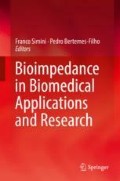Abstract
Tissue engineering can be defined as the application of the principles and methods of engineering and life sciences toward the fundamental understanding of structure-function relationships in normal and pathologic mammalian tissue and the development of biological substitutes to restore, maintain, or improve function. Despite its promising future, many challenges must be overcome before tissue engineering becomes the solution to reduce the number of deaths and injuries. Considering that cells and tissues can be characterized by their electrical properties, it is not difficult to realize that the bioelectrical impedance can be used to obtain information about physiological properties of an engineered tissue in a noninvasive and real-time way. This chapter does not intend to be an introduction to tissue engineering but to show that the application of the bioelectrical impedance technique in tissue engineering has already produced remarkable advances, including the development of commercial devices, but many aspects still need to be studied and developed because several challenges have not yet been solved.
Access this chapter
Tax calculation will be finalised at checkout
Purchases are for personal use only
References
Ahn, S., Wi, H., Oh, T. I., McEwan, A. L., Jun, S. C., & Woo, E. J. (2014). Continuous nondestructive monitoring method using the reconstructed three-dimensional conductivity images via GREIT for tissue engineering. Journal of Applied Mathematics, 2014.
Asami, K. (2002). Characterization of heterogeneous systems by dielectric spectroscopy. Progress in Polymer Science, 27(8), 1617–1659.
Asami, K., Takahashi, Y., & Takashima, S. (1989). Dielectric properties of mouse lymphocytes and erythrocytes. Biochimica et Biophysica Acta (BBA)-Molecular Cell Research, 1010(1), 49–55.
Bragós, R., Gámez, X., Cairó, J., Riu, P. J., & Gòdia, F. (1999). Biomass monitoring using impedance spectroscopy. Annals of the New York Academy of Sciences, 873(1), 299–305.
Canali, C., Mohanty, S., Heiskanen, A., Muhammad, H. B., Martinsen, Ø. G., Dufva, M., et al. (2015a). Impedance spectroscopic characterization of porosity in 3D cell culture scaffolds with different channel networks. Electroanalysis, 27(1), 193–199.
Canali, C., Heiskanen, A., Muhammad, H. B., Høyum, P., Pettersen, F. J., Hemmingsen, M., et al. (2015b). Bioimpedance monitoring of 3D cell culturing—Complementary electrode configurations for enhanced spatial sensitivity. Biosensors and Bioelectronics, 63, 72–79.
Cheneler, D., Buselli, E., Camboni, D., Anthony, C., Grover, L., Adams, M. J., et al. (2014). A bio-hybrid tactile sensor incorporating living artificial skin and an impedance sensing array. Sensors, 14(12), 23781–23802.
Diemert, S., Dolga, A. M., Tobaben, S., Grohm, J., Pfeifer, S., Oexler, E., et al. (2012). Impedance measurement for real time detection of neuronal cell death. Journal of Neuroscience Methods, 203(1), 69–77.
Dvir, T., Timko, B. P., Kohane, D. S., & Langer, R. (2011). Nanotechnological strategies for engineering complex tissues. Nature Nanotechnology, 6(1), 13–22.
Giaever, I., & Keese, C. R. (1984). Monitoring fibroblast behavior in tissue culture with an applied electric field. Proceedings of the National Academy of Sciences, 81(12), 3761–3764.
Grimnes, S., & Martinsen, Ø. G. (2008). Bioimpedance and bioelectricity basics (2nd ed.). Oxford, UK: Academic Press.
Heileman, K., Daoud, J., & Tabrizian, M. (2013). Dielectric spectroscopy as a viable biosensing tool for cell and tissue characterization and analysis. Biosensors and Bioelectronics, 49, 348–359.
Hildebrandt, C., & Thielecke, H. (2009). Non-invasive characterization of the osteogenic differentiation of hMSCs in 3D by impedance spectroscopy. In: World Congress on Medical Physics and Biomedical Engineering, September 7–12, 2009. Munich, Germany: Springer.
Holmes, D., Pettigrew, D., Reccius, C. H., Gwyer, J. D., van Berkel, C., Holloway, J., et al. (2009). Leukocyte analysis and differentiation using high speed microfluidic single cell impedance cytometry. Lab on a Chip, 9(20), 2881–2889.
Jaatinen, L., Sippola, L., Kellomäki, M., Miettinen, S., Suuronen, R., & Hyttinen, J. (2009). Bioimpedance measurement setup for the assessment of viability and number of human adipose stem cells cultured as monolayers. In: World Congress on Medical Physics and Biomedical Engineering, September 7–12, 2009. Munich, Germany: Springer.
Keese, C. R., & Giaever, I. (1994). A biosensor that monitors cell morphology with electrical fields. IEEE Engineering in Medicine and Biology, 13, 402–408.
Kell, D. B., Kaprelyants, A. S., Weichart, D. H., Harwood, C. R., & Barer, M. R. (1998). Viability and activity in readily culturable bacteria: A review and discussion of the practical issues. Antonie Van Leeuwenhoek, 73, 169.
K'Owino, I. O., & Sadik, O. A. (2005). Impedance spectroscopy: A powerful tool for rapid biomolecular screening and cell culture monitoring. Electroanalysis, 17(23), 2101–2113.
Markx, G. H. (2008). The use of electric fields in tissue engineering: A review. Organogenesis, 4(1), 11–17.
Moulton, S. E., Barisci, J. N., Bath, A., Stella, R., & Wallace, G. G. (2004). Studies of double layer capacitance and electron transfer at a gold electrode exposed to protein solutions. Electrochimica Acta, 49(24), 4223–4230.
Robert, L., Langer, R., & Vacanti, J. P. (Eds.). (2011). Principles of tissue engineering. Burlington, MA: Academic Press.
Sarró, E., Lecina, M., Fontova, A., Solà, C., Gòdia, F., Cairó, J. J., et al. (2012). Electrical impedance spectroscopy measurements using a four-electrode configuration improve on-line monitoring of cell concentration in adherent animal cell cultures. Biosensors and Bioelectronics, 31(1), 257–263.
Sarró, E., Lecina, M., Fontova, A., Gòdia, F., Bragós, R., & Cairó, J. J. (2016). Real-time and on-line monitoring of morphological cell parameters using electrical impedance spectroscopy measurements. Journal of Chemical Technology and Biotechnology, 91, 1755–1762.
Wright, J. E. I., Cosman, N. P., Fatih, K., Omanovic, S., & Roscoe, S. G. (2004). Electrochemical impedance spectroscopy and quartz crystal nanobalance (EQCN) studies of insulin adsorption on Pt. Journal of Electroanalytical Chemistry, 564, 185–197.
Author information
Authors and Affiliations
Corresponding author
Editor information
Editors and Affiliations
Rights and permissions
Copyright information
© 2018 Springer International Publishing AG, part of Springer Nature
About this chapter
Cite this chapter
de Souza, M.N. (2018). Tissue Engineering Instrumentation Based on Electrical Impedance Measurements. In: Simini, F., Bertemes-Filho, P. (eds) Bioimpedance in Biomedical Applications and Research. Springer, Cham. https://doi.org/10.1007/978-3-319-74388-2_6
Download citation
DOI: https://doi.org/10.1007/978-3-319-74388-2_6
Published:
Publisher Name: Springer, Cham
Print ISBN: 978-3-319-74387-5
Online ISBN: 978-3-319-74388-2
eBook Packages: EngineeringEngineering (R0)

